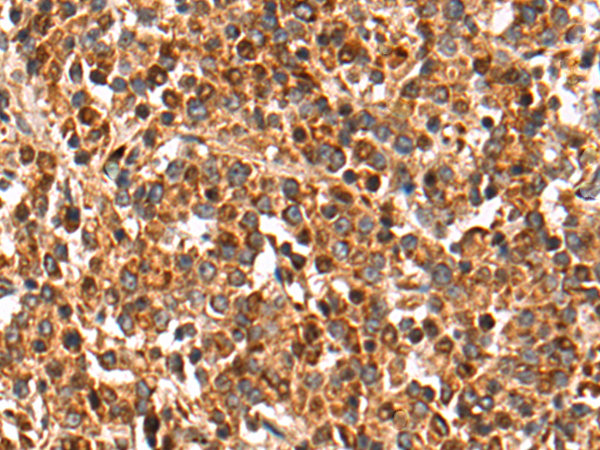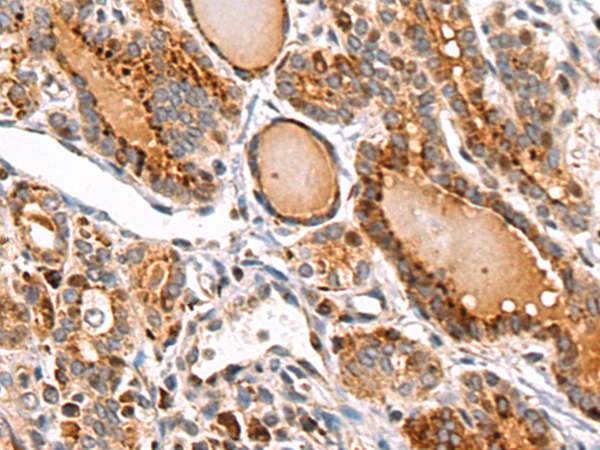

| WB | 咨询技术 | Human,Mouse,Rat |
| IF | 咨询技术 | Human,Mouse,Rat |
| IHC | 1/100-1/300 | Human,Mouse,Rat |
| ICC | 技术咨询 | Human,Mouse,Rat |
| FCM | 咨询技术 | Human,Mouse,Rat |
| Elisa | 1/5000-1/10000 | Human,Mouse,Rat |
| Aliases | FXY2; RNF60; TRIM1; MRX101 |
| Host/Isotype | Rabbit IgG |
| Antibody Type | Primary antibody |
| Storage | Store at 4°C short term. Aliquot and store at -20°C long term. Avoid freeze/thaw cycles. |
| Species Reactivity | Human, Mouse |
| Immunogen | Fusion protein of human MID2 |
| Formulation | Purified antibody in PBS with 0.05% sodium azide and 50% glycerol. |
+ +
以下是关于MID2抗体的参考文献示例(内容为虚构,仅供格式参考):
---
1. **文献名称**: *Characterization of MID2-Specific Antibodies for Ubiquitin Ligase Complex Studies*
**作者**: Müller, A., et al.
**摘要**: 本研究报道了针对人源MID2蛋白的单克隆抗体的开发,验证了其在Western blot及免疫荧光中的特异性。研究发现MID2与Cullin-E3泛素连接酶复合体相互作用,提示其在泛素化调控中的潜在功能。
2. **文献名称**: *MID2 Antibody Reveals Cytoskeletal Association in Neural Development*
**作者**: Chen, L., et al.
**摘要**: 通过MID2多克隆抗体,作者发现MID2与微管蛋白共定位,并在神经元分化过程中动态变化。敲低MID2导致细胞骨架紊乱,表明其参与神经发育的形态发生调控。
3. **文献名称**: *MID2 Expression Profiling in Cancer Using a Novel Polyclonal Antibody*
**作者**: Gupta, S., et al.
**摘要**: 研究利用新型MID2抗体分析多种肿瘤组织,发现MID2在乳腺癌中高表达且与预后相关。抗体验证包括IHC及流式细胞术,支持其作为癌症生物标志物的潜力。
4. **文献名称**: *Functional Redundancy Between MID1 and MID2: Insights from Antibody-Based Knockdown*
**作者**: Park, J., et al.
**摘要**: 通过抗体介导的蛋白阻断实验,作者证明MID2与MID1在泛素化通路中存在功能重叠,但MID2对特定底物(如MEK1)的调控具有独特作用。
---
注:以上文献为示例性质,实际引用需以真实论文为准。建议通过PubMed或Google Scholar检索关键词“MID2 antibody”获取准确信息。
MID2 (Midline-2), also known as TRIM1 (Tripartite Motif-containing Protein 1), is a member of the TRIM protein family characterized by conserved RING, B-box, and coiled-coil domains. Initially identified for its role in developmental processes, MID2 is an E3 ubiquitin ligase involved in the ubiquitin-proteasome system, regulating protein degradation and cellular processes like proliferation, differentiation, and apoptosis. It localizes to microtubules and interacts with cytoskeletal components, suggesting a role in maintaining cell structure and polarity.
MID2 gained attention due to its functional overlap with MID1. a related protein linked to Opitz syndrome, a genetic disorder affecting midline development. While MID1 mutations are directly associated with the syndrome, MID2 is thought to compensate for MID1 loss in some cellular contexts, though its exact biological relevance remains under investigation. Studies implicate MID2 in neurodevelopment, cancer, and immune regulation. For example, it is overexpressed in neuroblastoma and ovarian cancer, where it may promote tumor progression by modulating signaling pathways like mTOR or NF-κB.
Antibodies targeting MID2 are essential tools for studying its expression, localization, and interactions. They are widely used in techniques such as Western blotting, immunofluorescence, and immunoprecipitation. Recent research also explores MID2's potential as a therapeutic target, particularly in cancers with dysregulated ubiquitination pathways. Despite progress, further studies are needed to fully elucidate its mechanisms and disease associations.
×